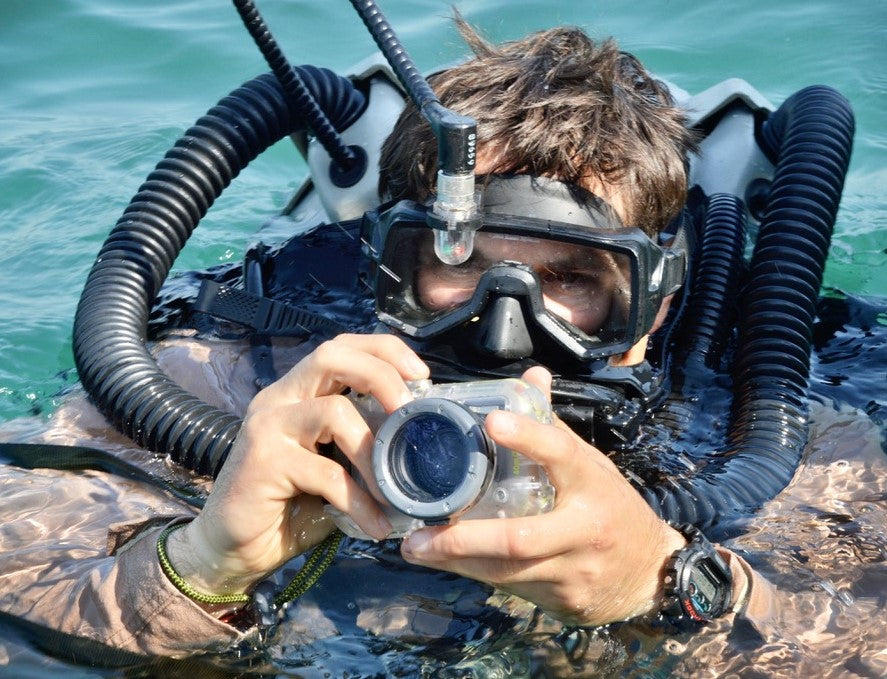The History Of G-Shocks And The US Military - Benjamin Lowry
Forty years have passed since the introduction of the Casio G-Shock in 1983. And while the basic formula behind the world’s most durable watch has remained largely unchanged since the legendary DW-5000C first hit store shelves, the world of warfare and the United States Military in particular have made significant strides in both equipment and tactical doctrine. Conflicts in Panama, the Persian Gulf, and Bosnia/Herzegovina were waged in a bygone analog era, influenced by lessons learned in the Vietnam War. But the terrorist attacks of September 11th changed all of that, embroiling the United States in a new type of war based on counter-insurgency in the digitally-augmented age.

(Photo Credit: National Archive)
For the average warfighter on the ground, old-school web gear gave way to modern plate carriers. The M16 was replaced by the M4 and other weapon systems. Reliable handheld GPS units succeeded the map and compass. Drones provided actionable intelligence to battlefield decision-makers in real-time, with coordination and collaboration provided by operations centers connected via the internet. Despite the advances, the role of a watch on the wrist and time as it relates to warfare was as crucial as ever. As the shifting tides of modern conflict replaced almost every aspect of kit, weapons, and equipment, millions of G-Shock watches did what they do best– surviving where other watches perished.

G-Shock DW-6900-1V worn by former Special Mission Unit Operator Erick Miyares when he was shot during an ambush in South America in 1999. (Photo Credit: Miyares, previous W.O.E. Guest Post)
But the G-Shock wasn’t always the legend we know it as today, and while the military use case seems natural, the watches weren’t designed with the military in mind. So how did a humble and inexpensive urethane-covered digital watch grow to become associated with the military? Further, how were iconic watches like the Rolex and Tudor Submariner or capable field watches from brands like Hamilton, Benrus, and Marathon cast aside by military organizations in favor of a watch more often associated at its inception with the United States West Coast skateboard and hip hop culture? The story starts in 1981 in Tokyo, Japan, with an intrepid Casio engineer named Kikuo Ibe.

The well-worn narrative goes that after famously dropping and destroying a pocket watch inherited from his father, Kikuo Ibe devised a plan to create a watch capable of what he called “Triple 10 Resistance”, able to withstand a 10-meter fall, 10-bar (100 meters) water resistance, and an extended battery life of 10 years. After some 200 prototypes and an epiphany after observing a child bouncing a rubber ball, Ibe invented the basic G-Shock design concept, a central water-resistant digital module crafted in stainless steel set deep within the safety of an outer flexible urethane structure intended to absorb, well, shocks.

A US Army Ranger in 1981 wearing an issued field watch alongside the quartz Breitling Chronomat 9108. (Photo Credit: National Archive)
In the US Military of the late 1970s and early 1980s, ground-based troops were often issued mechanical field watches like the GG-W-113 produced by both Hamilton and Benrus, with aquatic military units including the elite US Navy SEALs often opting for Tudor Submariners or Seiko dive watches, including the legendary 6309. Pilots and aircrew who weren’t busy playing volleyball shirtless or adjusting their Randolph Engineering aviator sunglasses wore a range of chronographs and GMT watches, often from brands like Rolex, Breitling, Citizen, Seiko, and Marathon. As you might expect, many military members also bought their own watches, but given the importance of timekeeping in armed conflict, the US Military of the early 1980s sought to equip the evolving service member with a reliable timepiece. Given the power of the almighty dollar in military spending, all signs were pointing to digital.
US Navy Divers in the pre-G-Shock era utilizing earlier digital watches from Casio. (Photo Credit: National Archive)
As an example, in 1983, the US Navy’s Experimental Diving Unit (NEDU) conducted a comprehensive test of six different digital watches, including two from Casio (the Marlin H110 and H101), two Seikos (the A547-5059 and A639-5029), the iconic Chronosport UDT, and a very similar and seldom-seen analog-digital Heuer. The brand-new-to-market G-Shock was left out of this particular test. Still, the success of the rest of these digital models under the NEDU’s intense subsea scrutiny demonstrated the shifting change of tides for analog mechanical watches.
For the first time, G-Shock presented military supply channels with a watch that was comparatively inexpensive while also offering incredible durability alongside the broad functionality offered by even the most basic digital watches. Almost no matter what your military specialty entailed, whether you were an elite maritime special operator, a fighter jet pilot, or a cook, even the most basic G-Shock was up to the task.

Navy SEALs conducting VBSS while wearing G-Shock, likely DW-6600 (Photo Credit: US Navy)
But before we get too deep into the weeds, it’s important to differentiate between the idea of gear such as a watch being “standard issue”, generally meaning everyone within a certain organization or specialty gets one, as opposed to being a “unit purchase”, which is to say bought for select units or even individuals through either government or sometimes private civilian channels with unit funds. Dozens of Casio G-Shock models have been purchased by various units on a smaller scale, but only four G-Shock references have ever been awarded a NA TO Stock Number or NSN, meaning those models have been tested and received the US Government’s blessing to be purchased through official channels and widely issued just as you would a pair of boots, a compass, or a canteen.

A US Marine Recon diver wearing the often-issued G-Shock 6900. (Photo Credit: National Archive)
For the nerds in the room, those officially-issued references are the DW-5600E-1V, DW-6600-1V, DW-6900-1V, and the DW-9052-1V that was until 2018 still issued to new Navy divers at Naval Diving and Salvage Training Center (NDSTC) as well as new SEAL candidates at Basic Underwater Demolition/SEAL (BUD/S) training. In these instances, the watches do not come in retail packaging but instead in a small brown cardboard box with a simple printed white label, exactly the kind of thing military watch nerds get all hot and bothered about.

US Navy SEAL Dave Hall wearing a Casio Pro-Trek, a close G-Shock relative. (Photo Credit: Dave Hall)
When the G-Shocks initially hit the market and military exchanges, some military members were slower to accept their use, especially when said military members counted themselves among the watch enthusiast crowd. Dave Hall, an especially pragmatic retired US Navy SEAL and the subject of a former Dispatch article was one such example. Despite having respect for the G-Shock’s durability and underwater legibility with the help of the backlight, Hall remembered treating the G-Shocks he was issued at his first few SEAL Teams as entirely disposable, not unlike a pair of fins with a broken strap or a leaky mask.
Retired Army Ranger Jose Gordon (stay tuned for his upcoming Dispatch profile) remembered when G-Shocks hit the market as well, but was reluctant to take off his proven automatic Seiko diver that had grown in sentimental value, proving itself in combat time and time again. However, in time, even these elite operators made the switch, finishing their careers in the first part of this century wearing G-Shock and other capable digital watches from brands like Suunto and Garmin. The fact of the matter is that the G-Shocks simply did the job better, more cheaply, and with less risk to other, more precious watches that had acquired sentimental status.

(Photo Credit: National Archive)
And while the G-Shock admittedly lacks some of the sex factor that comes with iconic mil-watches like the Tudor Submariners famously worn by the Frogmen of the Vietnam War, the humble G-Shock still forms emotional bonds with the operators who wear them. A good friend of mine is a US Coast Guard Diver and one of a select few humans on Earth to have dived in a military capacity beneath polar ice at both ends of the world. He is not a watch guy as such but proudly wears a G-Shock DW-6600 that bears a lot of meaning thanks to the intriguing way in which he acquired the watch.
The story goes that when sitting at the edge of a hole in the ice preparing for a dive near the North Pole with members of a West Coast SEAL Team (yes, seriously), my friend accidentally knocked the DW-9052 he had been issued at The Naval Diving and Salvage Training Center into around 13,000 feet of icy seawater, never to be seen again. Having taken the 9052 on all of his hundreds of training and operational dives to date, he was understandably bummed. A nearby Navy SEAL Master Chief also suiting up to dive saw the whole thing and muttered from beneath his bristly mustache something like “here, son, this one has served me well for the last twenty years or so…”, handing my friend his own weathered DW-6600, a watch he cherishes to this day and rudely refuses to sell to me.

American Sniper, Chris Kyle played by Bradley Cooper, wearing a G-Shock DW-6600-1V (Photo Credit: American Sniper)
In some ways, the history of G-Shocks and the US Military in particular offers a few tough pills to swallow. These incredibly durable, capable, functional, and legible digital watches facilitated a swift and unceremonious end to the era of issued mechanical analog watches that we watch nerds covet. In all of the watch spotting I do for my Instagram page, @SubmersibleWrist, I see at least fifty G-Shock watches in action for every cool mechanical watch. Leaving our hazy-eyed love of vintage mechanical tool watches aside just for a moment, it would be easy to form the argument that the G-Shock is history’s ultimate tool watch, boasting a forty-year reign that is substantially longer than the golden years of military use for almost all of the iconic watches we associate with uniformed service.

John Mayer/Hodinkee Collaboration G-Shock, G-Shock DW6900JM22-2 (Photo Credit: Hodinkee/John Mayer)
Despite its widespread acceptance among the military and mainstream pop cultural relevance, even earning the stamp of approval from John Mayer with his ongoing G-Shock collaboration with Hodinkee, the plastic-covered digital G-Shock isn’t for everyone. But for actual hard use of virtually any kind and especially military applications, the kind of things that would destroy your Rolex in seconds, the G-Shock remains the single best option on the market, as capable on the wrist of an elite special operator as it is on the archetypal Home Depot dad.
If you enjoyed this article, please consider signing up for our weekly free newsletter for further updates HERE.
Read Next: The Pragmatic Journey Of A SEAL Through Watch Collecting, by Benjamin Lowry
About The Author: Benjamin Lowry is a US Coast Guard veteran and commercial diver turned watch writer. These days, Ben splits his time between writing and video production in the watch industry and managing @SubmersibleWrist, a watch spotting account dedicated to military and commercial divers.









22 comments
I was a special boat operator in the Navy (SWCC). We were issued DW-6600 , at the time I could have cared less about the watch. It wasn’t till years later and the realization about how much of a beating the watch took did I fully appreciate this lowly issued watch. I now cherish this watch and plan on giving it to my son one day, I feel that watch has been on one hell of a journey. To be perfectly honest I think this same reason is why I love Toyota trucks in the same vain. We would have Toyota trucks on deployment and we would beat them mercifully. I truly gained an appreciation for Japanese engineering from then on out. I have since read about Japanese “Wabi Sabi”, and have a serious appreciation for well used things and the character they develop. There is just a natural relationship between Japanese products and the way they look when they are used for their intended purpose. It’s as of they get better looking with time and abuse.
I wore a couple of G Shocks while in Alaska as an Artillery Officer. I wish I could remember which ones but I was not into watches then (91-93). They held up under attic conditions one I transitioned to civilian I wore them until 1999 when I got a Casio Pathfinder which I wore for 20 years.
Thank you for your service and the great information you provide.
Thank you for a great article. By any chance do you know what’s been issued to diver trainees since 2018?
I was reading this article with my Casio A168 on my wrist. I chuckled when I saw that one diver wearing, what seems to be, a Casio A168 as well. Would be interesting to know how many dives did it survive. I have not babied mine and it is still “ticking”. Although, it has not gone deeper than 10cm below water surface (giving bath to my baby). As always, this was an interesting article. Thank you and keep going!
Thank you for your service; for this space for watch enthusiasts; and for this outstanding history of the Casio G-Shock in the Military. Fantastic article, and pictures as well! As I write this, I’m wearing my DW-6900LU that has been with me for about two years now. Prior to my G-Shock (G), I wore an original Luminox 3100 since 2002, which is still ticking and has some lume left in her. Back to the “G”…I was always intrigued by the “G” because of it’s history of successful military use; but was reluctant to buy a “G” because I always thought they were BIG and clunky…then I tried one on. I happened across mine at local store I frequent which NEVER has G-Shocks. This one day they had only one and I happily handed over the massive sum of $40 to become it’s proud owner. Thankfully I did because the store hasn’t had any since. Mine is basically a DW-6900-1V but is all grayed out (think MAS Gray) with black markings. I call it my “Stealth G”;) It just wears so well. I sometimes forget I have it on. And it’s functionality is great as I use them daily. Thank you again! Looking forward to more articles form WOE!